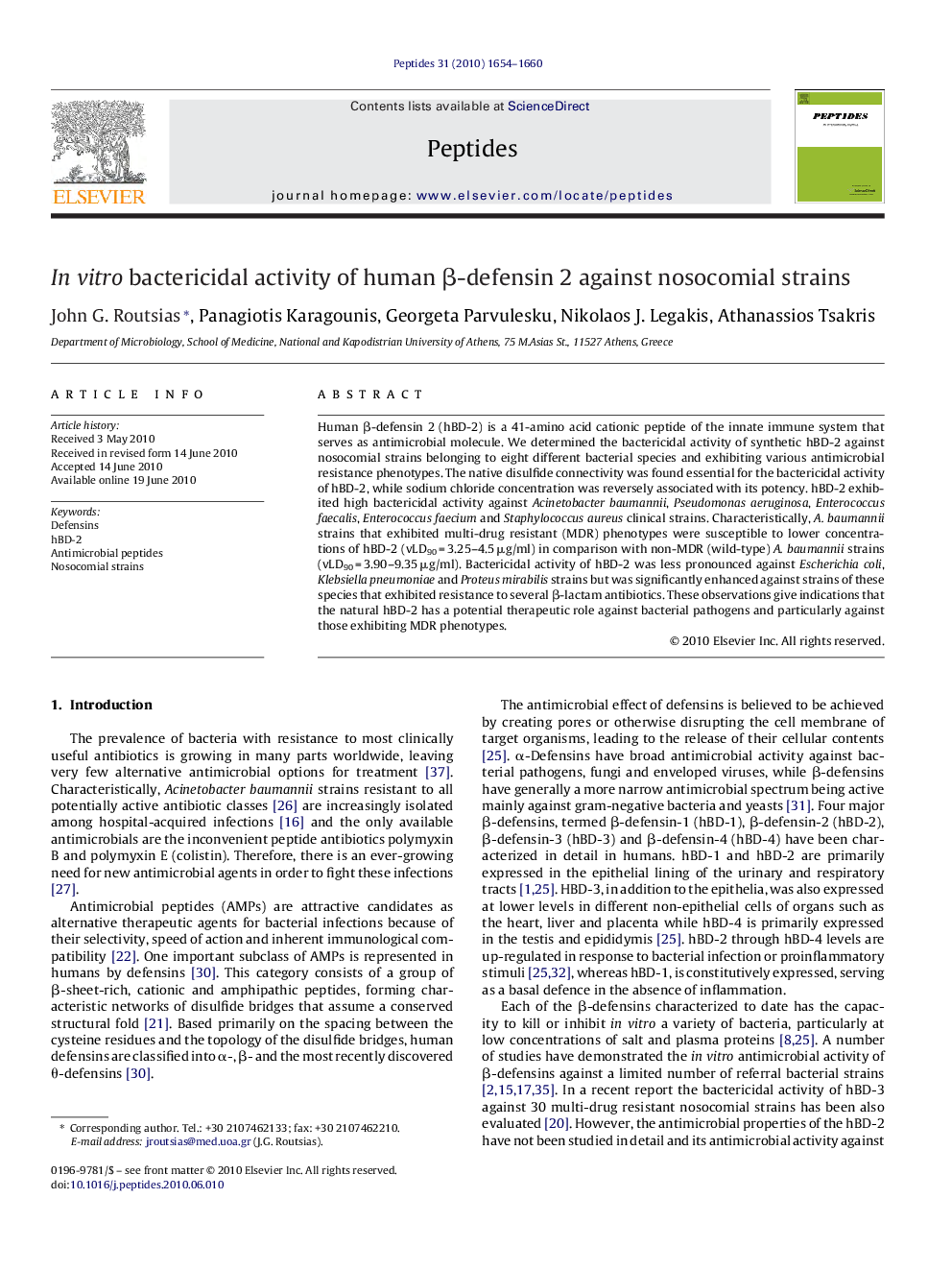| Article ID | Journal | Published Year | Pages | File Type |
|---|---|---|---|---|
| 2006813 | Peptides | 2010 | 7 Pages |
Human β-defensin 2 (hBD-2) is a 41-amino acid cationic peptide of the innate immune system that serves as antimicrobial molecule. We determined the bactericidal activity of synthetic hBD-2 against nosocomial strains belonging to eight different bacterial species and exhibiting various antimicrobial resistance phenotypes. The native disulfide connectivity was found essential for the bactericidal activity of hBD-2, while sodium chloride concentration was reversely associated with its potency. hBD-2 exhibited high bactericidal activity against Acinetobacter baumannii, Pseudomonas aeruginosa, Enterococcus faecalis, Enterococcus faecium and Staphylococcus aureus clinical strains. Characteristically, A. baumannii strains that exhibited multi-drug resistant (MDR) phenotypes were susceptible to lower concentrations of hBD-2 (vLD90 = 3.25–4.5 μg/ml) in comparison with non-MDR (wild-type) A. baumannii strains (vLD90 = 3.90–9.35 μg/ml). Bactericidal activity of hBD-2 was less pronounced against Escherichia coli, Klebsiella pneumoniae and Proteus mirabilis strains but was significantly enhanced against strains of these species that exhibited resistance to several β-lactam antibiotics. These observations give indications that the natural hBD-2 has a potential therapeutic role against bacterial pathogens and particularly against those exhibiting MDR phenotypes.
Research highlights▶ In this report we studied the bactericidal activity of human β-defensin 2 (hBD-2), a 41-amino acid cationic peptide of the innate immune system that serves as antimicrobial molecule. We determined the bactericidal activity of synthetic hBD-2 against nosocomial strains belonging to eight different bacterial species and exhibiting various antimicrobial resistance phenotypes. Our study describes the requirements for the bactericidal action of hBD-2 (e.g. disulfide connectivity and low salt concentrations). One extrapolation of these findings is that the maximum activity of hBD-2 can be found in sites of the human body with low salt concentration (e.g. airway surface fluid) and if the concentration of NaCl in that is increased (e.g. in cystic fibrosis) the bactericidal of hBD-2 is diminished. ▶ The evaluation of the bactericidal activity of hBD-2 against nosocomial strains. hBD-2 was found to be increased against Acinetobacter baumannii, Pseudomonas aeruginosa, Enterococcus faecalis, Enterococcus faecium and Staphylococcus aureus clinical strains. On the other hand, bactericidal activity of hBD-2 was less pronounced against Escherichia coli, Klebsiella pneumoniae and Proteus mirabilis clinical strains. ▶ The evaluation of the bactericidal activity of hBD-2 against multi-drug resistant (MDR) A. baumannii strains as well as against non-MDR A. baumannii strains. It was found that A. baumannii strains that exhibited multi-drug resistant (MDR) phenotypes were susceptible to lower concentrations of hBD-2 (vLD90 = 3.25–4.5 μg/ml) in comparison with non-MDR (wild-type) A. baumannii strains (vLD90 = 3.90–9.35 μg/ml). Given that MDR Acinetobacter isolates were susceptible only to nephrotoxic antibiotic colistin (polymyxin E), hBD-2 could be used as an altelnative, less toxic, therapeutic agent. ▶ The relation of the bactericidal activity of hBD-2 (against E. coli, K. pneumoniae and P. mirabilis) to antibiotic resistance phenotype of the strains. It was found that the bactericidal activity of hBD-2 was enhanced against strains that exhibited resistance to amoxicillin/clavulanate, aztreonam and all cephalosporins (P < 0.01). Therefore, hBD-2 has a potential therapeutic role against bacterial pathogens exhibiting resistance to several β-lactam antibiotics.
